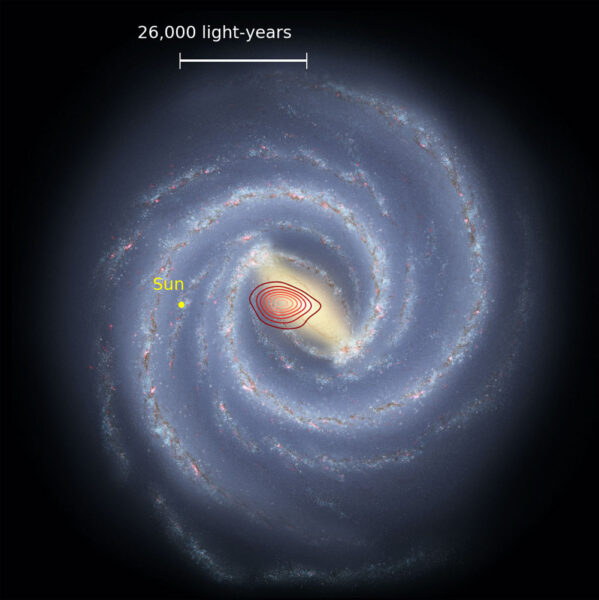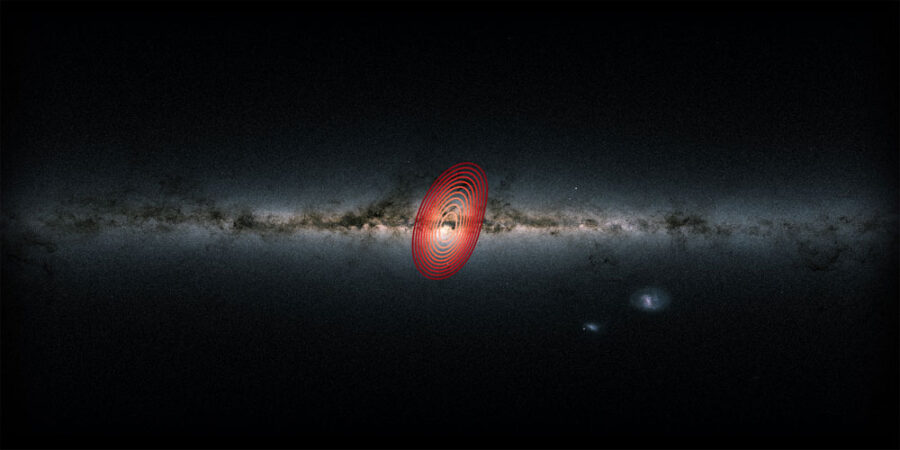Thousands of stars that once belonged to an ancient galaxy are inside our own.

Danny Horta-Darrington (Liverpool John Moores University) / NASA / JPL-Caltech / SDSS
Our galaxy is home to hundreds of billions of stars. While most of them were born here, a very few of them come from very far away. Among these, a team of astronomers has identified the stellar remnants of an ancient galaxy that collided with our own just after it formed.
Galactic archaeologists have discerned such stellar fossils using multiple approaches. For example, we recently reported on a study in which artificial intelligence trained on computer simulations to trace the origins of ancient stellar groups known as globular clusters.
Now, some astronomers are taking another approach. Graduate student Danny Horta and his advisor Ricardo Schiavon (both at Liverpool John Moores University, UK) along with an international team of colleagues, are using two giant surveys to catalog individual stars by the thousands. They combined data from the Gaia mission, which pinpoints the positions, distances, and velocities of stars, with chemical compositions obtained by the APOGEE sky survey.
Horta and his colleagues were looking for old stars, ones born before heavier elements forged in stellar cores could pollute nurseries. They zeroed in on 1,032 ancient ones within 13,000 light-years of the galactic center. The Gaia data reveal that some of these stars have unique, highly eccentric orbits, and APOGEE observations show these same stars have unusual compositions.
These stars, the researchers conclude in the Monthly Notices of the Royal Astronomical Society, are the fossilized remains of an ancient galaxy that collided with the Milky Way 10 billion years ago. The research team nicknamed the galactic fossil “Heracles,” after a hero from Greek mythology, who was granted immortality at the moment the Milky Way was created.
While some of the 300 or so stars actually traveled in with Heracles, the researchers speculate that the rest of these ancient stars were born within the Milky Way, their birth stimulated by the galactic merger. These stars joined our galaxy even before its current spiral-shape disk had formed, making up a sizable fraction of the stellar halo that now surrounds the disk.

Danny Horta-Darrington (Liverpool John Moores University) / ESA / Gaia / SDSS
Heracles vs. The Kraken
Despite the nickname Heracles, the galaxy that Horta and his colleagues describe sounds an awful lot like another recently discovered ancient galaxy, dubbed “The Kraken.”
“I think their scientific paper is very exciting, and it independently confirms our results,” says Diederik Kruijssen (Heidelberg University, Germany), who led the globular cluster study mentioned above. Indeed, both Heracles and the Kraken would have encountered our galaxy about 10 billion years ago on a similar orbital path, and their stars would have had similar chemical compositions.
However, Horta and Schiavon caution that the satellite they measure by the ancient stars around our galaxy’s center is almost three times as massive as what’s predicted by Kruijssen’s team.
“While Heracles is the true remnant of a stellar system, the Kraken is a prediction based on a statistical comparison of numerical simulations with the properties of the Galactic globular cluster system,” Schiavon explains. “Although some of the properties of Heracles match that prediction, it is not clear to us at this stage whether the globular clusters on the basis of which the Kraken is predicted are associated with Heracles.”
Heracles may indeed turn out to be the Kraken, but a convincing identification awaits additional data (such as that just released by Gaia last week) and numerical simulations.
“I definitely expect more ancient remnants to be discovered in the near future,” Kruijssen says. “About half a dozen progenitors have been found to date, but with improving analysis techniques and future data from Gaia and spectroscopic surveys like APOGEE, there is no question that there will be many more.”
 0
0









Comments
You must be logged in to post a comment.